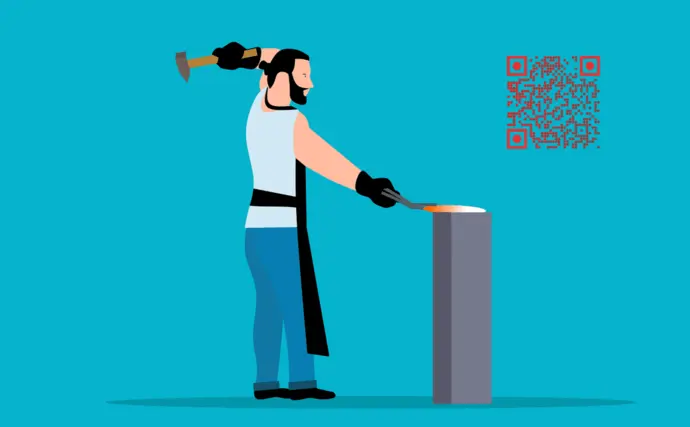You’re looking forward to creating a QR Code for one of your use cases. It could be promotional or operational in nature.
And why not? QR Codes are quite versatile, hence, they are used in various industries. Some of these include marketing, education, retail, payments, and inventory management.
Now, you’re actively looking for a unique QR Code that can help you stand out. And while searching, you came across an interesting concept—Engraved QR Code.
It is basically a QR Code etched to any kind of surface (metal, glass, or wood) using a specialized laser.
It is more than a design that meets the eye. It is an engraved design that interacts with people while getting them to respond by taking action. Hence, an Engraved QR Code might be what you need.
Keep reading to know more about engraved QR Codes.
A. Engraved QR Code: explained in minutes
As the name suggests, it’s a QR Code engraved or etched onto any material. It could be metal, wood, stone, glass, or any other element.
And like any QR Code, when scanned, this one will take the end-user to the encoded content. For example, website, image, video, or contact details.
That means, this QR Code can be used not only for its aesthetic appeal but for functional capabilities too.
Let’s see what all elements or materials can you engrave a QR Code on:
B. Types of engraved QR Codes
1. QR Codes on wood
Wood is one of the most common materials that QR Codes can be engraved on. It could be wooden keychains, decor, plaques, etc.
And the best part is that wood is a sustainable choice. This means it is long-lasting, biodegradable, recyclable, and reusable. This makes it a good choice for all environment lovers.
It can also be a material of choice for interior designers and decorators. While wood would add aesthetic value to the project, a QR Code will make it interactive and functional. Providing a clear interior design brief to the designer can ensure that the QR Code is integrated seamlessly into the overall design, adding value to the project.
2. QR Code on metal
Metal is yet another multi-purpose element. From electronic appliances to cars, they’ve got it all covered. And it makes sense. Various metals are sturdy and tough against aging, heat, or even damage.
But engraving on metal is not easy. It takes a highly skilled person to carve every bit and element of the QR Code on metal of your choice.
One common use of QR Codes is on gold jewelry. That’s right. Many people now engrave a QR Code on their ornaments. It could be to deliver a special text message, video, audio, or a whole mobile landing page for your loved one. This makes the other receiver feel special.
Similarly, QR Codes can also be found on steel, silver, copper, etc. These are particularly used for metallic business cards, nameplates, or boards.
For better understanding, here’s an example. A UK-based designer Chris Parry creates QR Code cufflinks. These cufflinks are handmade with sterling silver. People can encode secret messages on the QR Code and gift them to their loved ones.
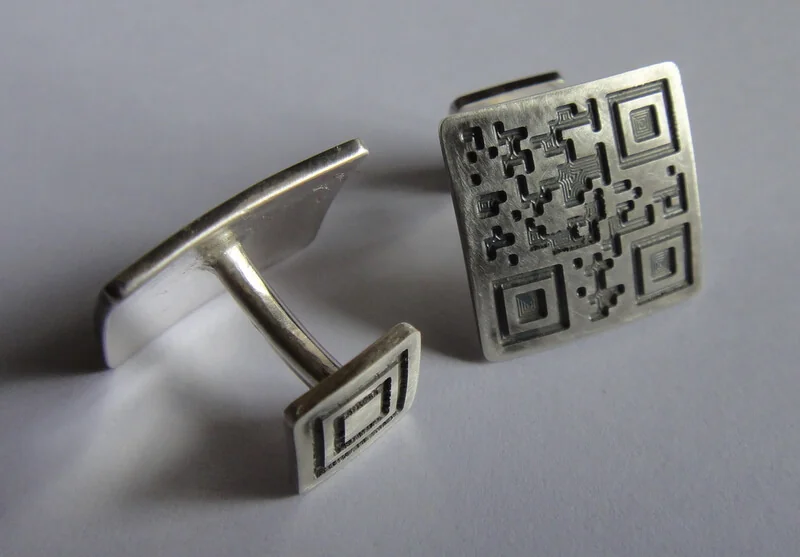
3. QR Code on glass
Have you ever seen a QR Code etched on a transparent glass? Well, many marketers use that. They add the QR Code on materials made of glass such as windows, bottles, and glasses.
For example, say you are a wine glass manufacturer. And you have decided to increase your social media following.
To do it, you can engrave QR Codes on your wine bottles and glasses. When filled with wine, it will give a good contrast to the QR Code. The customers can scan the QR Code to follow them online.
To help you understand it better, here’s an example. In 2012, BBDO, an American marketing agency, created a QR Code campaign for the alcoholic beverages brand, Guinness. They developed a QR Code Guinness beer cup.
Generate a QR Code For Your Unique Case
START TODAY!
This QR Code got revealed only when the cup was filled. Customers could scan it to post updates on social media, collect coupons from Guinness, and also view the brand’s promotional content.
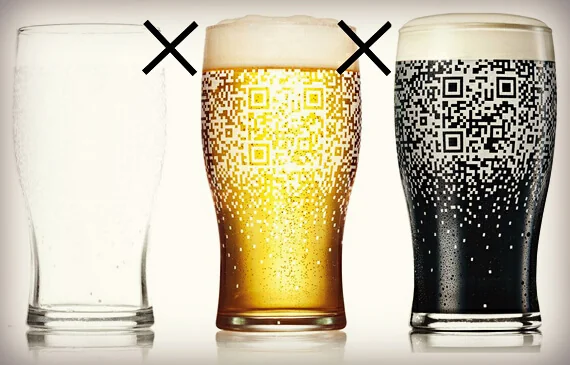
4. Acrylic QR Code stands
Acrylic is a well-known durable and eco-friendly material. Hence, it is widely used across industries.
And just like Glass, you can also engrave QR Code on the Arcylic stands. They are quite popular in the signage industry. But that’s not where it ends. It can also act as the perfect medium for all marketing campaigns. This will, in turn, boost your brand awareness.
5. Stone QR Code
Just like Metal, Stones are quite solid and sturdy. And they have been a testament to various historical events on this planet.
And now, they’re witnessing the evolution of technology too. Many people are using QR Codes on stones for various use cases. Paying a tribute to their beloved departed ones via headstones is one of them.
For example, funeral companies in Denmark are adding QR Codes. These QR Codes honor the dead with a link to their online presence. The largest gravestone manufacturer in Denmark has incorporated this technology in memorials.
In addition, you can also them on the streets or the sidewalks to provide directions to the tourists. For example, as part of the FIFA 2014 mania in Brazil, QR Codes were used extensively to provide information to tourists.

Tourists could see QR Codes on almost every street in Brazil. Upon scanning they got instant access to the history and culture of the city.
C. Popular use cases of engraved QR Codes
Now you know the elements of engraved QR Code, let’s see what kind of content you can share with them:
1. Product information
Are you a business owner or a manager? Then you’d know how important it is for you to share product information with your customers. And this is true for every industry.
Being transparent about your product is one of the best ways to build customer trust. And QR Codes help you do just that. They help you provide as much information as you want without worrying about the limited printing space on your product packaging.
All that you need to do is—create a Product QR Code and add the required details to it. It could be images, text, website links, video, and even social media sharing buttons.
Once you create this QR Code, you can add it to material products made of wood, metal, or glass. Your customers can then scan the QR Code to see complete product details.
2. Share your contact details
You know how important it is to share your contact details with your potential customers. It allows them to quickly contact you if they’d like to get in touch.
And a VCard QR Code helps you to do it. How? Just engrave it on any materials such as metal business cards or glass windows in your stores.
People can then scan the QR code to see all your contact details. It could be your name, contact number, email, address, website, and even your social media handles. Along with these, they also see the option—Save as Contact.
That means they can save you as a contact with a single click. That’s it. No need for them to manually type your details to add you as a contact (which seldom happens).
3. Share documents
Say you have to share documents such as restaurant menu, T&C, or warranty details with your customers. To do it, you often send physical or digital copies of these documents.
But there is a better way to do it—Document QR Code. How? Simply create one by adding all the files that you need. And add this as an engraved QR Code on metal, wood, glass, or acrylic stands.
People can just scan the QR Code to view and download the document on their phones. Easy, right?
This is quite useful for businesses that want to make their premises look unique and impressive. And what better choice is there other than acrylic QR Code menu stands?
4. Information about artifacts and monuments
Many museums and art galleries are switching to QR Codes to provide details about an artifact or monument to visitors.
To do it, they usually take the help of the following QR Codes:
- Landing Page QR Code: It takes the end-user to a mobile-optimized landing page having multiple layers of information such as images, graphics, and even videos. Here, you can add monuments images, graphics, or explanatory video
- Text QR Code: As people scan it, it will show the text encoded in it. It can be anything such as the detailed history of an artifact
- Audio QR Code: This QR Code, when scanned, takes the end-users to an audio file. It can be audio guides for your museums or art gallery
These QR Codes can then be placed at appropriate places for the visitors to scan.
5. Guide customers to your store
Say you have sparked the interest of your customers and now they want to visit your store. But they don’t know your store’s exact location.
Here, a Google Maps QR Code can enable you to help them visit your store. How? When they scan it, they’ll be able to see the exact map’s location to your store on their phones. No need for them to ask for directions.
You can add it to your metal business cards, wooden keychains, or any other company product. Once done, you will see the rise in walk-ins.
D. How to create an engraved QR Code
Here’s the next big question—how to create an engraved QR Code?
1. Decide on the QR Code category
Depending on what content you would like the end-users to see on scanning the QR Code, you would have to select the right QR Code category.
For example, if you want to provide detailed product information, you’d need a Product QR Code. On the other hand, if you want to share your business’s location, you’ll have to create a Google Maps QR Code. Here’s a list of categories that you can choose from.
Once you’ve decided on the QR Code category, you have to find a suitable QR Code generator. You can also refer to this detailed comparison of the best QR Code generator available online. It’ll help you make a sound decision as per your requirements.
2. Create a QR Code
Using Scanova for demo purposes, here’s how you can create an engraved QR Code:
a. Go to Scanova
b. From the QR Code categories, select the relevant QR Code category
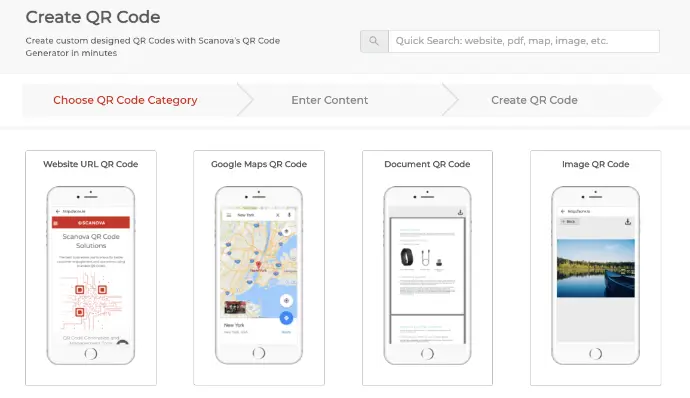
c. Now add the content you want to encode and click Continue
d. Now, you’ll be asked to name the QR Code. Once done, click Create QR Code
e. On the page that loads, you’ll see the preview of the QR Code on the right with the Edit Design option
f. If you click on the Edit Design option, you’ll see two design options to choose from—Custom Logo Design and Custom Background Design

Custom logo design: It allows you to add a logo in the center and colors to the QR Code. The logo design can be an image or text.
Custom background design: It helps you place your QR Code on an image.
g. Once you’ve decided on the design, Update it and click Download. A window will open prompting you to sign-up for a 14-day free trial. Once you’ve signed up, proceed to download the QR Code
Note that no credit card information is required to sign-up.
h. Now you’ll be asked to specify the QR Code image’s size and dimensions. Once you submit the details, click Export
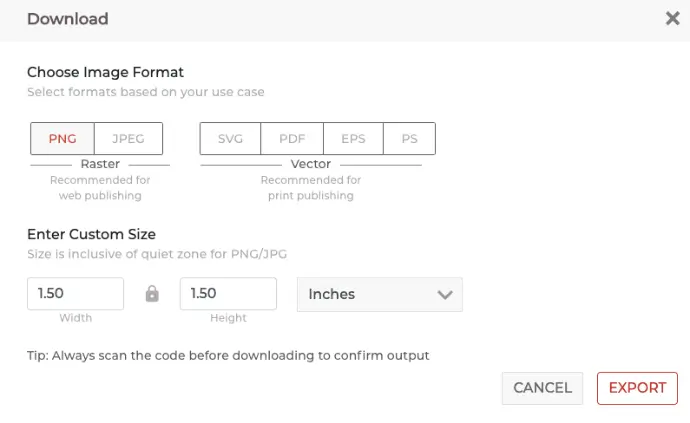
That’s it. Your QR Code will be downloaded and ready for use. It is always advisable to test scan the QR Code before putting it out for your customers.
E. Things to know before getting an Engraved QR Code
You know that QR Code’s information is stored in the dots of their intricate design (data modules). So it is important to make sure that your engraved design scans well.
So here are three things that you should know before getting an engraved QR Code:
1. Make sure you hire an expert
You will obviously want a skilled person to do the job. And that’s important too. Why?
A QR Code is made up of a matrix of dots (also called data modules). And these dots store the target data. When a scanner reads a QR Code, it counts on each one of these dots. That means every single data module is important.
Hence, your artist must have the expertise to carve the QR Code well
So make sure you ask all the important questions before hiring someone. You can even do a quick PI test to evaluate their overall suitability for the role. See if he has ever made an engraved QR Code before. And what is his success rate in getting an engraved QR Code that scans well?
These questions will help you identify the right person for your use case.
2. Choose permanent content
You’d want your QR Code to always remain functional and meaningful. So you must ensure that it is free of long-term problems. What does that mean?
It means you need to choose permanent content. For example—say you’ve encoded a website link in your QR Code. A year later, the website no longer exists. Your QR Code will then become useless.
So you should rather add permanent content to QR Code here. It could be text that conveys your life motto, a famous quote, etc.
For example—you can use a Text QR Code on headstones to give detailed information about the deceased person. Here, they can help you tell the story of the dead person. Hence, the departed will be remembered forever.
And to add permanent content such as text, choose a static QR Code. It’s permanent in nature. Once you create it, you cannot edit it. And it remains functional forever.
3. Make sure your QR Code is highly scannable
a. Add error correction to your QR Code
You know barcodes. They don’t get scanned once they get damaged, right? But that’s not the case with QR Codes.
They remain scannable even after wear and tear. That’s because they have error correction capabilities. And it’s important to ensure maximum scanability.
There are four levels of error correction:
- Level L: sustains up to 7% damage
- Level M: sustains up to 15% damage
- Level H: sustains up to 25% damage
- Level V: sustains up to 30% damage
Depending upon the rough environment your QR Code is going to be in, you can select the right one.
b. Ensure enough color contrast
It is very important to ensure high color contrast between QR Code and its background. That’s because it ensures that your QR Code scans well.
So, if you have a light-colored material, go for darker shades of the QR Code. And similarly, if you have a dark-colored material, go for lighter shades of QR Code.
c. Adequate QR Code size and scanning distance
The QR Code size and the distance between the QR Codes and the scanner (smartphone) are important for its scannability.
And for that, you need a QR Code of the right size and the scanner at the right distance. That’s because the ideal scanning distance directly depends on the size of the QR Code.
For example, a QR Code that’s 2cm X 2cm in size, won’t be scannable from 100 cm away.
Sounds fair, right? But you cannot rely on guesstimates all the time. So, for your convenience, you can calculate the right size of the QR Code via a basic rule.
The ratio of scanning distance to the QR Code’s size should be close to 10:1. That means if a QR Code is to be scanned from 100 cm away, it must be at least 10 cm wide.
You now know engraved QR Code’s best practices.
That’s it. That is all you need to know about engraved QR Codes. You can now create your own engraved QR Code and revamp your business operations.
Generate a QR Code For Your Unique Case
START TODAY!
